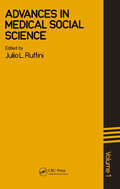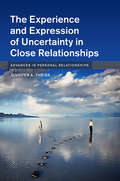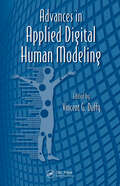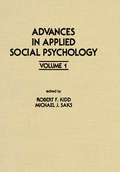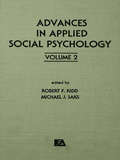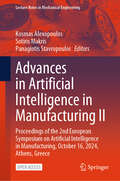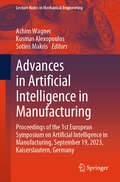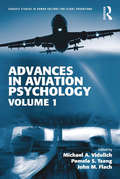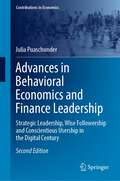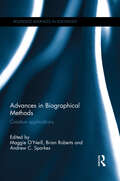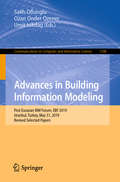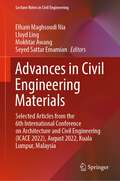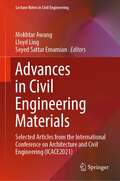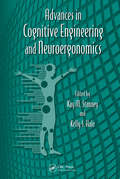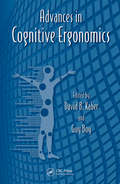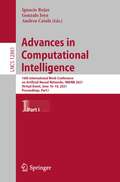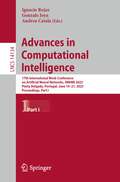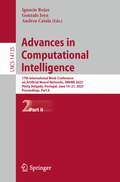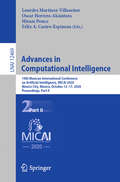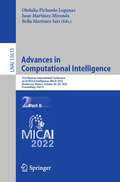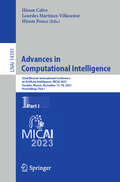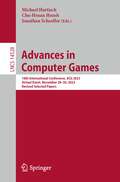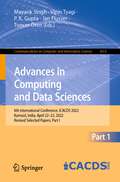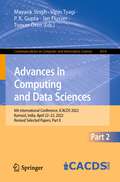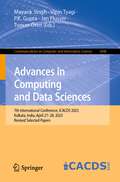- Table View
- List View
Advances In Medical Social Sciences
by Julio L. RuffiniFirst Published in 1984. The aim of this annual series is to increase communication between health social scientists and to show how anthropology, sociology, psychology, geography, economics and political science, all contribute to our understanding of health and illness, This first volume of devoted to an overall survey of the field. Future volumes will concern themselves with the most recent advances in the various areas of study.
Advances In Personal Relationships: The Experience and Expression of Uncertainty in Close Relationships (Advances in Personal Relationships)
by Jennifer A. TheissClose relationships are an important and desired aspect of the human experience; but as individuals pursue intimacy and connection with others, they will encounter a variety of questions about the nature, status, and future of their relationships. Consequently, uncertainty is an inevitable and unavoidable element of close relationships. It can arise in response to a variety of relational circumstances and can shape the ways that partners think, feel, and act toward one another. This book summarizes the expansive body of theoretical and empirical research regarding the nature of uncertainty, the conditions that promote uncertainty about relational involvement, and the emotional, cognitive, and communicative outcomes of uncertainty for individuals and their relationships. Based on the robust accumulation of data about uncertainty in close relationships, the book also offers recommendations for coping with ambiguous relational circumstances and proposes new directions for conceptualizing and studying uncertainty in close relationships.
Advances in Applied Digital Human Modeling (Advances in Human Factors and Ergonomics Series)
by Vincent G. DuffyThis volume is concerned with digital human modeling. The utility of this area of research is to aid the design of systems that are benefitted from reducing the need for physical prototyping and incorporating ergonomics and human factors earlier in design processes. Digital human models are representations of some aspects of a human that can be ins
Advances in Applied Social Psychology: Volume 1 (Applied Psychology Series)
by Michael J. Saks Robert F. KiddFirst published in 1980. Routledge is an imprint of Taylor & Francis, an informa company.
Advances in Applied Social Psychology: Volume 2 (Applied Psychology Series)
by ROBERT F. KIDD and MICHAEL J. SAKSFirst Published in 1983. This volume is the second in a series of volumes on applied social psychology. The contents of the contributions represent the richly diverse approaches and settings in which social psychology is being used. In preparing their chapters, the contributors were asked to focus on how social psychologists,' as scientists and advocates, could contribute to the resolution of the debates that often surround important social problems. Each author was asked to place his or her attempts to use social psychological knowledge in the context of his or her own specific problem. If one consistent theme emerges from this collection, it is the emphasis on employing social psychology to enlighten and understand decisions at the level of public policy. This book is a vital display of how existing literature and methods in the field can work to illuminate and inform issues of national and even international importance.
Advances in Artificial Intelligence in Manufacturing II: Proceedings of the 2nd European Symposium on Artificial Intelligence in Manufacturing, October 16, 2024, Athens, Greece (Lecture Notes in Mechanical Engineering)
by Sotiris Makris Kosmas Alexopoulos Panagiotis StavropoulosThis open access book reports on recent developments of artificial intelligence applications in the manufacturing industry. Gathering contributions to the second European Symposium on Artificial Intelligence in Manufacturing, held on October 16, 2024, in Athens, Greece, it reports on machine learning, deep learning and generative AI models for process monitoring, optimization, and control, flexible and precise industrial robots, human-robot collaboration, data management and information technologies, digital twins, data augmentation and synthetic data. Giving a special emphasis to the integration of artificial intelligence in manufacturing systems, automation and processes, this book offers a timely and practice-oriented guide to a multidisciplinary audience of engineering researchers, system developers, AI scientists and industrial managers.
Advances in Artificial Intelligence in Manufacturing: Proceedings of the 1st European Symposium on Artificial Intelligence in Manufacturing, September 19, 2023, Kaiserslautern, Germany (Lecture Notes in Mechanical Engineering)
by Sotiris Makris Kosmas Alexopoulos Achim WagnerThis book reports on recent developments of artificial intelligence applications in the manufacturing industry. Gathering contributions to the first European Symposium on Artificial Intelligence in Manufacturing, held on September 19, 2023, in Kaiserslautern, Germany, it reports on machine learning models and algorithms for systems monitoring and industrial data management, on advances in human-robot collaboration, and on artificial intelligence applications in industrial control and process monitoring. Giving a special emphasis to the integration of artificial intelligence in manufacturing systems and processes, this book offers a timely and practice-oriented guide to a multidisciplinary audience of engineering researchers, software developers and industrial managers.
Advances in Aviation Psychology: Volume 1 (Ashgate Studies in Human Factors for Flight Operations #1)
by Michael A. VidulichAviation remains one of the most active and challenging domains for human factors and applied psychology. Since 1981, the biennial International Symposium on Aviation Psychology (ISAP) has been convened for the purposes of (a) presenting the latest research on human performance problems and opportunities within aviation systems, (b) envisioning design solutions that best utilize human capabilities for creating safe and efficient aviation systems, and (c) bringing together scientists, research sponsors, and operators in an effort to bridge the gap between research and application. Though rooted in the presentations of the 17th ISAP, held in 2013 in Dayton, Ohio, Advances in Aviation Psychology is not simply a collection of selected proceeding papers. Based upon the potential impact on emerging trends, current debates or enduring issues present in their work, select authors were invited to expand on their work following the benefit of interactions at the symposium. The invited authors include the featured keynote and plenary speakers who are all leading scientists and prominent researchers that were selected to participate at the symposium. These contributions are supplemented by additional contributors whose work best reflects significant developments in aviation psychology. Consequently the volume includes visions for the next generation of air management and air traffic control, the integration of unmanned (i.e. remotely piloted vehicles) into operational air spaces, and the use of advanced information technologies (e.g. synthetic task environments) for research and training. This book is the first in a series of volumes to be published in conjunction with each subsequent ISAP. The aim of each volume is not only to report the latest findings in aviation psychology but also to suggest new directions for advancing the field.
Advances in Behavioral Economics and Finance Leadership: Strategic Leadership, Wise Followership and Conscientious Usership in the Digital Century (Contributions to Economics)
by Julia PuaschunderThis book explores human decision-making heuristics. The monograph studies how nudging and winking can help citizens to make rational choices and governments to create choice architectures that aid in stabilizing markets and flourishing society. By applying the behavioral economics approach to political outcomes, it demonstrates how economics can be employed for personal benefits but also foster the greater societal good. A review of the current literature on human decision-making advantages and failures in Europe and North America opens the book. A wide range of nudges and winks is presented that aid to curb the harmful consequences of human decision-making fallibility. Awareness of mental heuristics and biases in the finance domain is strengthened in order to understand how to nudge people to benefit from economic markets but also help governments to stabilize economies in providing strategic market communication. The author also proposes concrete leadership and followership directives on nudging in the digital age. This book appeals to scholars and policy makers interested in rational decision-making. The behavioral perspective features the strategic use of nudging and winking in the digital age.The second revised and expanded edition offers the newest insights on behavioral e-Economics and the latest developments regarding the COVID-19 pandemic. It covers topics such as the role of social media in finance and discrimination in searchplace competition. It also offers new insights on strategic leadership and smart followership directives to successfully navigate through complex and fast-paced e-architectures.
Advances in Biographical Methods: Creative Applications (Routledge Advances in Sociology)
by Brian Roberts Andrew C. Sparkes Maggie O’NeillRooted in a long and diverse genealogy, biographical approaches have developed from a focus upon a single story, a ‘life story’ and personal documents (e.g. diaries), to encompass (more routinely) autobiographical secondary and archival research and analysis - as well as multi-media, arts based creative multi-sensory methods. Biographical Research and practices as part of human understanding helps people to make sense of what has been and what is happening in their lives, cultures, communities and societies. Advances in Biographical Methods: Creative Applications takes up these themes: theorising, doing and applying current advances in biographical methods. It demonstrates the momentum with which they areas are developing as a field of scholarship, especially in relation to creative innovations and applications, such as in new forms of interview and other practices, and debates on its interlinking with art, performance and digital methods.
Advances in Building Information Modeling: First Eurasian BIM Forum, EBF 2019, Istanbul, Turkey, May 31, 2019, Revised Selected Papers (Communications in Computer and Information Science #1188)
by Umit Isikdag Salih Ofluoglu Ozan Onder OzenerThis book constitutes the refereed proceedings of the First Eurasian BIM Forum, EBF 2019, held in Istanbul, Turkey, in May 2019. The 16 full papers were carefully reviewed and selected from 44 submissions. The papers cover such topics as BIM adoption and implementation; BIM for project management; BIM for sustainability and performative design; BIM and facility management and infrastructural issues.
Advances in Civil Engineering Materials: Selected Articles from the 6th International Conference on Architecture and Civil Engineering (ICACE 2022), August 2022, Kuala Lumpur, Malaysia (Lecture Notes in Civil Engineering #310)
by Mokhtar Awang Seyed Sattar Emamian Lloyd Ling Elham Maghsoudi NiaThis book presents selected articles from the 6th International Conference on Architecture and Civil Engineering 2022 (ICACE 2022), held in Malaysia. Written by leading researchers and industry professionals, the papers highlight recent advances and addresses current issues in the fields of civil engineering and architecture.
Advances in Civil Engineering Materials: Selected Articles from the International Conference on Architecture and Civil Engineering (ICACE2021) (Lecture Notes in Civil Engineering #223)
by Mokhtar Awang Seyed Sattar Emamian Lloyd LingThis book presents selected articles from the 4th International Conference on Architecture and Civil Engineering 2021, held in Malaysia. Written by leading researchers and industry professionals, the papers highlight recent advances and addresses current issues in the fields of civil engineering and architecture.
Advances in Cognitive Engineering and Neuroergonomics (Advances in Human Factors and Ergonomics Series)
by Kelly S. Hale Kay M. StanneyThis volume explores cognitive ergonomics, which is concerned with mental processes-otherwise known as brain work. It discusses perception, memory, reasoning, and motor response, as they affect interactions among humans and other elements of a system. Topics will include mental workload, decision-making, skilled performance, human-computer interaction, human reliability, work stress and training as these relate to human-system design.
Advances in Cognitive Ergonomics (Advances in Human Factors and Ergonomics Series)
by Guy Boy David B. KaberThe chapters in the book come from an international group of authors with diverse backgrounds including ergonomics, psychology, architecture, computer science, engineering, and sociology. Specific topics include biometric systems development, military command and control, cellular phone interface design, methodologies for workplace design, medical
Advances in Computational Intelligence: 16th International Work-Conference on Artificial Neural Networks, IWANN 2021, Virtual Event, June 16–18, 2021, Proceedings, Part I (Lecture Notes in Computer Science #12861)
by Ignacio Rojas Gonzalo Joya Andreu CatalaThis two-volume set LNCS 12861 and LNCS 12862 constitutes the refereed proceedings of the 16th International Work-Conference on Artificial Neural Networks, IWANN 2021, held virtually, in June 2021.The 85 full papers presented in this two-volume set were carefully reviewed and selected from 134 submissions. The papers are organized in topical sections on Deep Learning for Biomedicine, Intelligent Computing Solutions for SARS-CoV-2 Covid-19, Advanced Topics in Computational Intelligence, Biosignals Processing, Neuro-Engineering and much more.
Advances in Computational Intelligence: 17th International Work-Conference on Artificial Neural Networks, IWANN 2023, Ponta Delgada, Portugal, June 19–21, 2023, Proceedings, Part I (Lecture Notes in Computer Science #14134)
by Ignacio Rojas Gonzalo Joya Andreu CatalaThis two-volume set LNCS 14134 and LNCS 14135 constitutes the refereed proceedings of the 17th International Work-Conference on Artificial Neural Networks, IWANN 2023, held in Ponta Delgada, Portugal, during June 19–21, 2023.The 108 full papers presented in this two-volume set were carefully reviewed and selected from 149 submissions.The papers in Part I are organized in topical sections on advanced topics in computational intelligence; advances in artificial neural networks; ANN HW-accelerators; applications of machine learning in biomedicine and healthcare; and applications of machine learning in time series analysis. The papers in Part II are organized in topical sections on deep learning and applications; deep learning applied to computer vision and robotics; general applications of artificial intelligence; interaction with neural systems in both health and disease; machine learning for 4.0 industry solutions; neural networks in chemistry and material characterization; ordinal classification; real world applications of BCI systems; and spiking neural networks: applications and algorithms.
Advances in Computational Intelligence: 17th International Work-Conference on Artificial Neural Networks, IWANN 2023, Ponta Delgada, Portugal, June 19–21, 2023, Proceedings, Part II (Lecture Notes in Computer Science #14135)
by Ignacio Rojas Gonzalo Joya Andreu CatalaThis two-volume set LNCS 14134 and LNCS 14135 constitutes the refereed proceedings of the 17th International Work-Conference on Artificial Neural Networks, IWANN 2023, held in Ponta Delgada, Portugal, during June 19–21, 2023. The 108 full papers presented in this two-volume set were carefully reviewed and selected from 149 submissions. The papers in Part I are organized in topical sections on advanced topics in computational intelligence; advances in artificial neural networks; ANN HW-accelerators; applications of machine learning in biomedicine and healthcare; and applications of machine learning in time series analysis. The papers in Part II are organized in topical sections on deep learning and applications; deep learning applied to computer vision and robotics; general applications of artificial intelligence; interaction with neural systems in both health and disease; machine learning for 4.0 industry solutions; neural networks in chemistry and material characterization; ordinal classification; real world applications of BCI systems; and spiking neural networks: applications and algorithms.
Advances in Computational Intelligence: 19th Mexican International Conference on Artificial Intelligence, MICAI 2020, Mexico City, Mexico, October 12–17, 2020, Proceedings, Part II (Lecture Notes in Computer Science #12469)
by Oscar Herrera-Alcántara Lourdes Martínez-Villaseñor Hiram Ponce Félix A. Castro-EspinozaThe two-volume set LNAI 12468 and 12469 constitutes the proceedings of the 19th Mexican International Conference on Artificial Intelligence, MICAI 2020, held in Mexico City, Mexico, in October 2020. The total of 77 papers presented in these two volumes was carefully reviewed and selected from 186 submissions. The contributions are organized in topical as follows: Part I: machine and deep learning, evolutionary and metaheuristic algorithms, and soft computing. Part II: natural language processing, image processing and pattern recognition, and intelligent applications and robotics.
Advances in Computational Intelligence: 21st Mexican International Conference on Artificial Intelligence, MICAI 2022, Monterrey, Mexico, October 24–29, 2022, Proceedings, Part II (Lecture Notes in Computer Science #13613)
by Obdulia Pichardo Lagunas Juan Martínez-Miranda Bella Martínez SeisThe two-volume set LNAI 13612 and 13613 constitutes the proceedings of the 21st Mexican International Conference on Artificial Intelligence, MICAI 2022, held in Monterrey, Mexico, in October 2022.The total of 63 papers presented in these two volumes was carefully reviewed and selected from 137 submissions.The first volume, Advances in Computational Intelligence, contains 34 papers structured into three sections:Machine and Deep LearningImage Processing and Pattern RecognitionEvolutionary and Metaheuristic AlgorithmsThe second volume contains 29 papers structured into two sections:Natural Language ProcessingIntelligent Applications and Robotics
Advances in Computational Intelligence: 22nd Mexican International Conference on Artificial Intelligence, MICAI 2023, Yucatán, Mexico, November 13–18, 2023, Proceedings, Part I (Lecture Notes in Computer Science #14391)
by Hiram Calvo Lourdes Martínez-Villaseñor Hiram PonceThe two-volume set LNAI 14391 and 14392 constitutes the proceedings of the 22nd Mexican International Conference on Artificial Intelligence, MICAI 2023, held in Yucatán, Mexico, in November 2023.The total of 49 papers presented in these two volumes was carefully reviewed and selected from 115 submissions.The proceedings of MICAI 2023 are published in two volumes. The first volume, Advances in Computational Intelligence, contains 24 papers structured into three sections:– Machine Learning– Computer Vision and Image Processing– Intelligent SystemsThe second volume, Advances in Soft Computing, contains 25 papers structured into three sections:– Natural Language Processing– Bioinformatics and Medical Applications– Robotics and Applications
Advances in Computer Games: 18th International Conference, ACG 2023, Virtual Event, November 28–30, 2023, Revised Selected Papers (Lecture Notes in Computer Science #14528)
by Jonathan Schaeffer Michael Hartisch Chu-Hsuan HsuehThis book constitutes the refereed post proceedings of the 18th International Conference on Advances in Computer Games, ACG 2023, held online, during November 28–30, 2023.The 14 full papers included in this book were carefully reviewed and selected from 29 submissions. They were organized in topical sections as follows: Chess and its Variants, Solving Games, Board Games, Card Games, Player Investigation, Math, Games, and Puzzles.
Advances in Computing and Data Sciences: 6th International Conference, ICACDS 2022, Kurnool, India, April 22–23, 2022, Revised Selected Papers, Part I (Communications in Computer and Information Science #1613)
by Tuncer Ören Jan Flusser Mayank Singh P. K. Gupta Vipin TyagiThe two-volume proceedings CCIS 1613 + 1614 constitute revised selected papers from the 6th International Conference on Advances in Computing and Data Sciences, ICACDS 2022, which was held in Kurnool, India in April 2022.The total of 69 full papers presented in the proceedings was carefully reviewed and selected from 411 submissions. The papers focus on advances of next generation computing technologies in the areas of advanced computing and data sciences
Advances in Computing and Data Sciences: 6th International Conference, ICACDS 2022, Kurnool, India, April 22–23, 2022, Revised Selected Papers, Part II (Communications in Computer and Information Science #1614)
by Tuncer Ören Jan Flusser Mayank Singh P. K. Gupta Vipin TyagiThe two-volume proceedings CCIS 1613 + 1614 constitute revised selected papers from the 6th International Conference on Advances in Computing and Data Sciences, ICACDS 2022, which was held in Kurnool, India in April 2022.The total of 69 full papers presented in the proceedings was carefully reviewed and selected from 411 submissions. The papers focus on advances of next generation computing technologies in the areas of advanced computing and data sciences.
Advances in Computing and Data Sciences: 7th International Conference, ICACDS 2023, Kolkata, India, April 27–28, 2023, Revised Selected Papers (Communications in Computer and Information Science #1848)
by Tuncer Ören Jan Flusser Mayank Singh P. K. Gupta Vipin TyagiThis book constitutes the refereed proceedings of the 7th International Conference on Advances in Computing and Data Sciences, ICACDS 2023, held in Kolkata, India, during April 27–28, 2023. The 47 full papers included in this book were carefully reviewed and selected from 22 submissions. The papers focus on advances of next generation computing technologies in the areas of advanced computing and data sciences.
